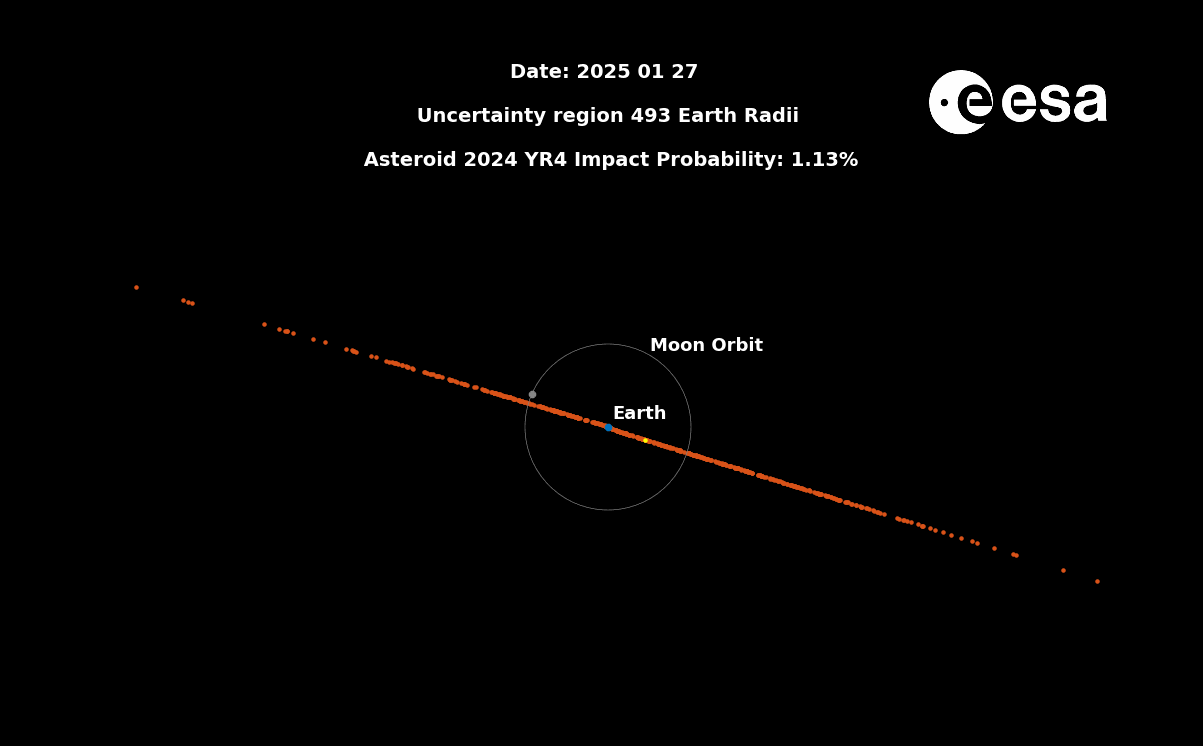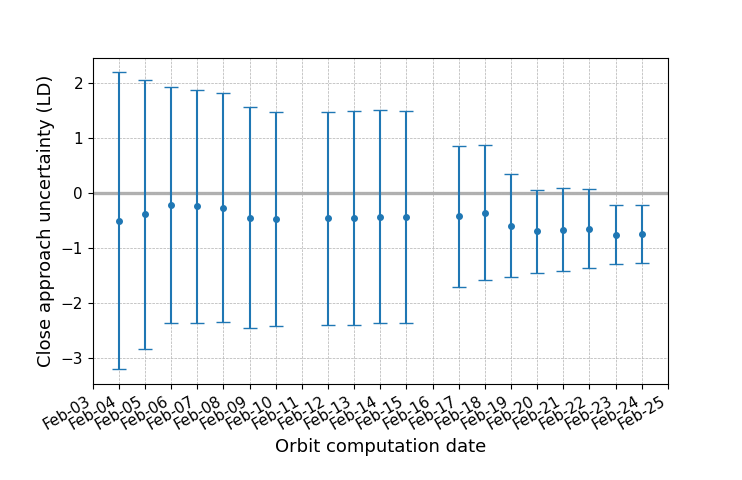These are the latest estimates for the size and impact probability of asteroid 2024 YR4 from ESA’s Near-Earth Object Coordination Centre (NEOCC), as of 25 February 2025. See our Frequently Asked Questions for more information.
| Asteroid designation | Size (diameter) | Probability of Earth impact | Date of potential Earth impact |
| 2024 YR4 | 40—90 m | Insignificant | 22 December 2032 |
Find out why an asteroid’s impact probability can change over time, and why it often falls to zero:
Here is the equivalent representation for 2024 YR4, based on real observational data:


As new observations of the asteroid are made and we continue to study its trajectory, we gain a clearer understanding of how close it will get to our planet.
The dot at the centre of each blue line represents the orbit that best fits the observations available up to that date. The grey line at 0 on the Y-axis represents Earth, with a width of roughly 12 756 km.
This graph uses data from observations made up to 24 February 2025. Credit: ESA/Planetary Defence Office
Updates
25 Feb:
The latest analysis from ESA has reduced the probability that asteroid 2024 YR4 might impact Earth in 2032 to 0.001%. The object has fallen from Level 3 to Level 0 on the Torino Impact Hazard Scale and no longer requires significant attention. The asteroid is no longer at the top of ESA’s risk list, and the International Asteroid Warning Network has concluded its related activities.
21 Feb:
- The probability that asteroid 2024 YR4 might impact Earth on 22 December 2032 has dropped from 2.8% to 1.4% to 0.16% in just a couple of days.
Thanks to new observations, Earth is now at the edge of our shrinking ‘uncertainty window.’ If this trend continues, the risk may soon reach 0%.
19 Feb:
- 2024 YR4 briefly surpasses the 2.7% impact probability reached by the asteroid Apophis 20 years ago
10 Feb:
Webb will study 2024 YR4 asteroid in infrared light to provide a much more accurate estimate of the asteroid’s size. It will also observe the asteroid once it is beyond the limits of ground-based telescopes to provide the final measurements of its orbit until it returns to view in 2028.
6 Feb:
- ESA’s Near-Earth Object Coordination Centre has published its February newsletter.
The monthly newsletter summarises the latest news in planetary defence. The February 2025 edition focusses on asteroid 2024 YR4.
3 Feb:
- The Space Mission Planning Advisory Group (SMPAG) will continue to monitor the situation.
SMPAG coordinates the international response to any asteroid larger than 50 m across with a greater than 1% chance of impacting Earth within the next 50 years. As 2024 YR4 is currently very close to these size and impact probability thresholds, the group has decided to continue monitoring the situation before initiating any further action.
SMPAG will meet again in late April or early May as the asteroid fades from view to re-evaluate the situation, or earlier in the unlikely event that the impact risk increases significantly. Should the asteroid’s estimated diameter remain above 50 m, and the impact probability remain above 1%, SMPAG will issue a recommendation about further action to the United Nations Office for Outer Space Affairs (UNOOSA).
30 Jan:
- The International Asteroid Warning Network (IAWN) has published its Potential Asteroid Impact Notification.
IAWN coordinates world-wide observations of asteroids larger than 10 m with an impact probability greater than 1%. This notification acknowledges that IAWN is now actively coordinating observations of 2024 YR4.
- ESA’s Near-Earth Object Coordination Centre (NEOCC) has published its first Close Approach Fact Sheet on asteroid 2024 YR4.
The NEOCC produces fact sheets on asteroids that will pass Earth in a noteworthy manner. They provide an overview of ESA’s current understanding of the asteroid’s important characteristics and its encounter with Earth.
29 Jan:

Discussion: 24 comments
Why negative observations are not taken into account when publishing probability of impact?
Thanks for the great question, Gianmarco!
Negative observations can be a good way to reduce our uncertainty about an asteroid’s orbit around the Sun.
To conduct negative observations, astronomers look for the asteroid in older pictures of the night sky. If the asteroid doesn’t appear in certain places at certain times, they can rule out some of its possible orbits.
The hope would be to eliminate the few possible orbits that could lead to an Earth impact.
There is a protocol agreed upon by ESA, JPL, the Minor Planet Center (MPC) and the Near-Earth Objects Dynamics Site (NEODyS) that describes under what conditions we can accept a negative observation for use in our risk assessments.
As of writing, no negative observations of 2024 YR4 have met all of the necessary criteria.
For reference, this is the protocol in question: https://minorplanetcenter.net/media/documentation/negative_observations/VI_Observations_Protocol_3.1.pdf
Dear ESA, What is the probability of 2024 YR4 asteroid hitting the Moon on 22/12/2032? Do we know that? Thank you!
As a guess, the probability will be in the ratio of the cross-section the Moon shows to the cross-section the Earth shows. Which is the ratio of the squares of the radius of the targets.
(Adjust for atmosphere, and a bit for gravity)
That estimate must change if the expected distance goes down below 1 earth-moon distance.
The size of asteroid 2024 YR4 is currently estimated to be around 40-100 meters. However, if it turns out to have an extremely low albedo, is there a possibility that its actual size could be as large as 200 or even 300 meters? I’m not only concerned about the increasing probability of impact but also the chance that it might be unexpectedly as large as Apophis
Concuerdo totalmente contigo!, he tenido la misma duda desde que aumentó la probabilidad. Inclusive, si esta probabilidad fuese creciente mes a mes con el mismo o cercano al porcentaje de crecimiento como se descubrió ahora, la probabilidad de impacto en el año 2032 sería más del 50%… Deja mucho para pensar…
o asteroide 2024 yr4 vai bater na terra em 2032 ou nao?
talvez … eu acho que o trajetória final vai ser ~5000 quilômetros en cima da terra … e isto é perto demais, fecha para maior conforto
Dear ESA, Addirionally to my previous question, in case of 2024 YR4 asteroid not hitting the Moon, but passing by very close, would we be so unlucky that the Moon’s gravity slightly diverts the asteroid towards the Earth in the end? Thank you!
It could also be the opposite, the moon deflects away from Earth.
I’ll buy popcorn to watch the Fireworks.
But I agree, I would love to hear about calculations hitting the moon, but I fear it is too early for that yet.
Whatever will happen, thanks a ton for your hard work!
Why does the figure show a 1D distribution instead of 2D? Why is there no spread of the distribution perpendicular to the red line? How can you be so certain that it will pass somewhere along that red line?
I would guess this is because the object travels in an elliptical path that lies in an orbital plane, and the orientation of that plane is easier to pin down with limited observations than the exact size and shape of that ellipse.
teniendo presente el tamaño del Sistema solar: nuestra casa, el tamaño de la Via Lacte; nuestro Jardín, estimo que un 2% de probabilidades de acertar en la Tierra esa Roca “””es una gigantesca posibilidad””” El Sistema Solar: Nuestra Humilde Morada en la Inmensidad Cósmica
Imagina el Sistema Solar, nuestra casa, como un pequeño jardín dentro de la inmensa Vía Láctea, nuestro vecindario cósmico. Las distancias son tan colosales que nuestra mente apenas puede comprenderlas.
Si lanzáramos una roca al azar desde cualquier punto de este “jardín” galáctico, ¿cuál sería la probabilidad de que impactara la Tierra? A pesar de la inmensidad del espacio, las probabilidades de acertar en nuestro planeta no son tan insignificantes como podríamos pensar.
Con un tamaño estimado de 100.000 años luz de diámetro, la Vía Láctea alberga miles de millones de estrellas y planetas. Nuestro Sistema Solar, con apenas unos pocos años luz de extensión, es solo un punto minúsculo en esta vasta estructura.
Sin embargo, la “gigantesca posibilidad” de acertar en la Tierra se revela al considerar que nuestro planeta es un objetivo relativamente grande en comparación con otros cuerpos celestes. Además, la gravedad del Sol y de la Tierra misma aumenta las probabilidades de que una roca perdida termine en nuestro camino.
Is this asteroid larger or smaller than the one that wiped out the dinosaurs?
this one is way smaller. the asteroid that wiped out the dinosaurs was between 35,000 and 50,000 feet long. this one is between 100 and 300 feet long. so the asteroid that wiped out the dinosaurs was between 110 to 500 times larger than this one
Way smaller. Dinosaurs was 10-15 kilometers (6-9,5 Miles) this one is 40-90 meters (131 – 295 Feet)
Where can I find current coordinates for 2024 YR4? The sky live website is down.
So the date is determined: 2023-12-22, the possible angle: 84°. And what about the time?
This is the uncertain part. We don’t know the time yet. The orbit of 2024 yr4 is pretty clear, which is why we have an impact corridor. What is uncertain is when the meteor is gonna intersect with earth’s orbit around the sun, and this uncertainty of a few hours is the difference between earth getting hit or being 500,000 km away. Current observations are being done to refine this time down until it is small enough that we know for certain whether it hits or not. The orbit of the asteroid is already clear.
~•~Thanks ESA Wonderful Amazing Organization~•~
Hope to report a simple discovery (using my good basic phone app) that Asteroid 2024 YR4 will pass near Mars (perhaps extremely close?) during many hours in the last week of May in the year 2148 …
While I don’t have any idea if this apparent close pass qualifies as a “potential” Martian impact, I do find it fascinating to speculate weak gravitational effects on the somewhat unstable orbits of the two martian moons Phobos & Deimos …
Simplified public dialog is important in all science endeavors, so I timidly respectfully wonder if shortening the good proper name of “Asteroid 2024 YR4” to the very easily translatable word “wire” may promote general public education? This new name “wire” refers to the sound the consonants “Y+R” make when their names are pronounced together …
Asteroid “Wire” conveniently conveys the closeness of the 2032 passing approach to Earth and is easy to translate into Spanish, Portuguese, French, Hausa, Yoruba, Sango, Oromo, Somali, Arabic, Gujarati, Hindi, Bengali, some of the many beautiful languages in the possible path-range … I feel Asteroid Wire Sounds good.
Optimistic News Headline:
‘Asteroid “Wire” Will Safely Pass Earth Only a Few Thousand Miles Above Atmosphere’ (maybe)
Thanks Again ESA~Free World Needs Your Wisdom!
YR4 art thou, Romeo?
Hello is 0.16% the correct number below 1%?
I’ve been enjoying watching the daily solutions evolve.
Would be really interested in a a blog post some day with some of the operational, math, and science details of how this played out…
There has to be a untold cool science story here.